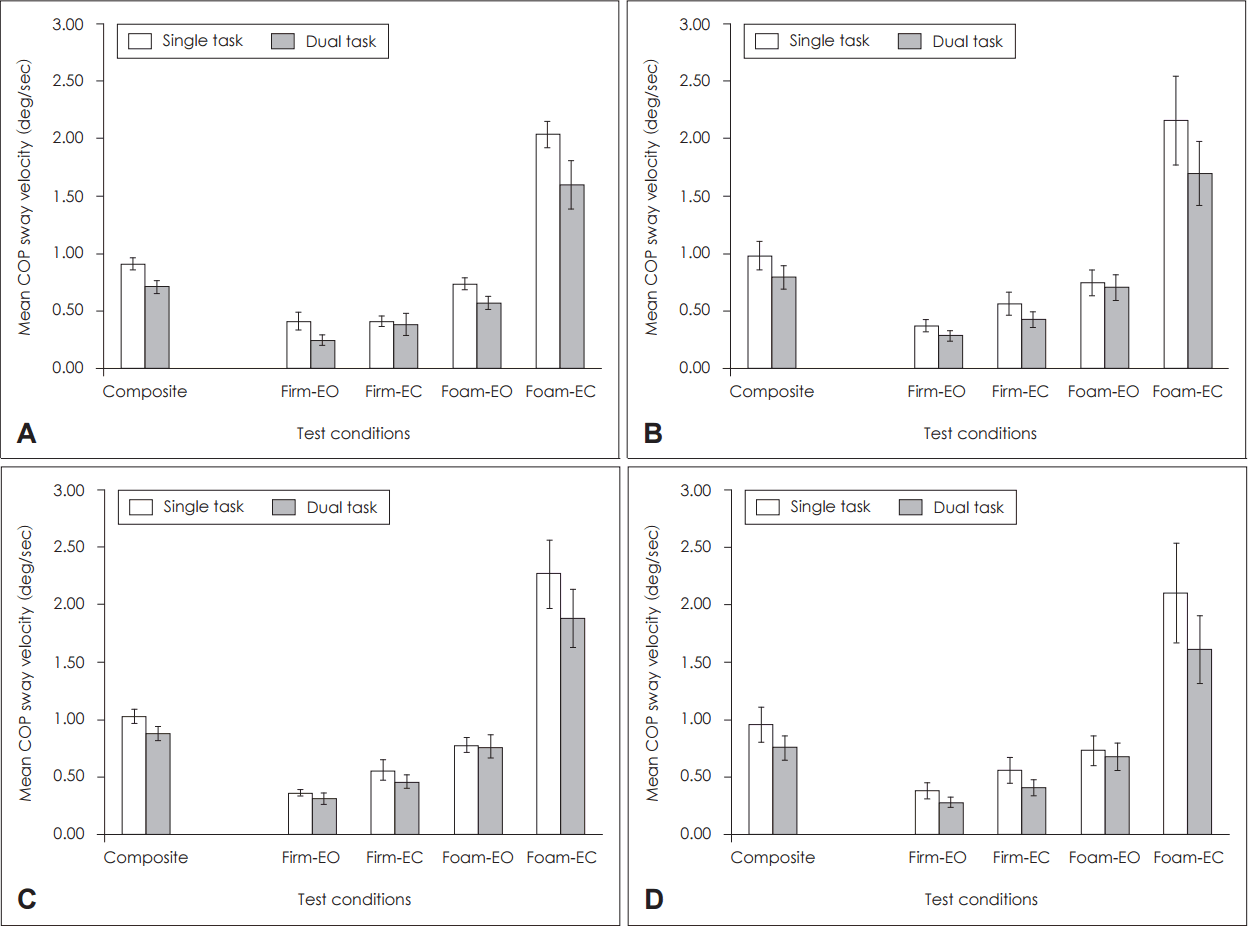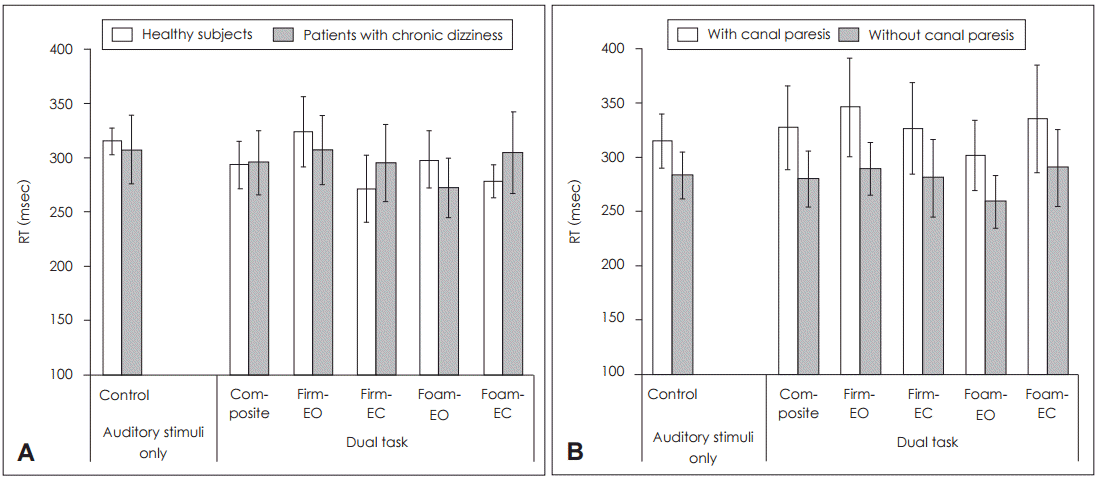Introduction
Sensory input from visual, vestibular and somatosensory systems provide fundamental information for balance and posture control in humans. Posture control is coordinated by the central nervous system that integrates the sensory information and relays appropriate motor control. Notably, cognitive functions such as attention are required in posture control [
1,
2].
During the acute phase of peripheral vestibular dysfunction, the patients suffer severe symptoms of vertigo and deficits in posture control, highlighted by lateropulsion and difficulty in performing Romberg tests. In compensated phase, most of the patients are able to perform daily activities without much distress even though vestibular hypofunction may persists as evidenced by caloric test, rotational chair test or vestibular evoked myogenic potential tests. However, a portion of patients experienced persistent vestibular symptoms that hinder their return to the daily routine. In these patients, while the subjective measures of the vestibular symptoms reflect the burden on daily activities, the results of dynamic posturography testing are often within normal range and their frustration may be overlooked by the physicians as mere emotional or psychological.
The ability to maintain an erect posture commands complex sensory-motor and cognitive processes [
3]. Attentional demand for maintaining a given posture is increased in various conditions including normal aging, after stroke and musculoskeletal disorders [
3-
7]. Increased attentional demand has been correlated with increased fall risks [
8,
9]. Based on these studies, we hypothesized that some patients with “compensated” vestibulopathy experience vestibular symptoms due to increased attentional demand for posture control in everyday life situations where the attentional must be allocated for execution of multiple tasks as well as balance control.
In this study, we aimed to assess the feasibility of dual task test using concurrent cognitive task to the modified clinical test of sensory interaction on balance (mCTSIB) to measure the increased attentional demand for posture control in patients with persistent vertigo symptoms.
Go to :

Discussion
Integration of multi-sensory input is required for maintenance of posture control. Posture and balance control is challenged in many situations during everyday life. For example, crossing the street is comprised of a number of tasks, such as stopping and maintaining posture, head turning and surveillance of possible danger, initiation of movement and walking at appropriate speed. Patients with acute vestibulopathy suffer from severe vertigo and imbalance and the symptoms usually subside as the vestibular loss is compensated [
12]. However, some patients with compensated or minimal vestibular hypofunction complain of subjective disequilibrium or sensation of imbalance, as well as easy fatigue during their daily routine. We hypothesized that such symptoms may be due to increased attentional demand.
Dynamic posturography and mCTSIB are useful tools to evaluate the functional status of balance and posture control. However, many patients with normal test results may still have balance problems. Various modifications of balance tests have been explored to investigate balance problems not readily evident from conventional balance tests [
13-
15]. Attentional demand can be measured by dual task paradigm. Attention is allocated between maintaining posture and performing the additional cognitive task. It has been reported that attentional demand is increased in elderly patients, after stroke and other disorders [
3-
7].
In our study, we measured the RT to auditory stimulus as a measurement of attentional demand. In normal subjects, RT to auditory stimulus was not prolonged in more challenging situations, such as eye closure or standing on foam. The results showed a trend toward prolonged RT in patients with chronic dizziness and balance symptoms compared to healthy subjects, although not statistically significant. The trend may reflect increased attentional demand required for posture control takes up capacity for prompt response in the additional task. It is possible that in our study group, the additional task of responding to the auditory task was too easy to have significant effect on attentional reallocation. However, the study by Jehu, et al. [
16] showed that addition of cognitive RT task improved posture control, possibly because the postural stability helped the subjects to perform the cognitive RT task. Futures studies are needed to clarify the interaction between the posture control and RT tasks, using various cognitive RT tasks.
It is noteworthy that the COP sway was decreased during dual task situations compared to during single task situation of standing still, both in healthy subjects and patients with chronic dizziness. Previous studies also report better posture control when attention focus is removed from internal focus during quiet stance and sports activities [
17,
18]. A recent study showed that prioritizing attention to a RT task and away from the posture control actually improved postural stability [
16]. Jehu, et al. [
16] concluded that when the secondary RT task was complex and required more attentional demand, the subjects may have adapted stiffening strategy that resulted in better posture control. Our results may be explained in a similar manner, suggesting that the subjects unknowingly prioritized the secondary RT task, even though they were not instructed to prioritize the RT task.
During dual task tests, COP sway velocity showed tendency to increase in difficult circumstance such as Foam-EC. This change in COP sway velocity can be explained due to increased difficulty in maintaining posture with more perturbations in sensory inputs. On the other hand, RT measurements were not increased as we have expected. Since RT measurements are used to investigate increased attentional demand for posture control in more difficult conditions, our results might indicate that RT to auditory stimuli is not significantly affected by postural instability in the test conditions. Since RT is an analysis of sensory and neuromotor function that encompasses stimulus recognition and processing, followed by the initiation of a neuromotor response, the RT to auditory stimuli might be rapid and easily adaptive during four test conditions. Another possible assessment tool is to utilize more complex cognitive tasks to measure attentional demand during posture control.
Limitations of this study include the heterogeneity of the patient population. Some patients suffered chronic dizziness symptoms due to insufficient compensation after acute vestibulopathy, and some were diagnosed as chronic non-specific dizziness after neurologic and vestibular testing. Also included are some patients who reported a history of an episodic or recurrent attack of BPPV, after which they experienced prolonged dizziness symptoms. No nystagmus was observed from physical examinations, and subjective dizziness symptoms were chronic in nature. Since the dual task test attempted to investigate whether attentional demand was included in patients with chronic symptoms, these patients were also enrolled. Further studies are needed to investigate whether increased attentional demand is responsible for chronic dizziness symptoms in specific vestibular disorders. Another remaining question is the possibility that attentional demand is increased only after protracted course of vestibular diseases. In such case, dual task test results may change over the disease course. Future studies should be directed to investigate contribution of increased attentional demand in dizziness symptoms at different duration of disease.
The various factors such as sex, age, health of status, and academic background may affect the attentional demand as mentioned above [
19]. The RT is shortest in twenties, and generally shows a tendency to increase with age. Also, shorter RT was generally reported in male, better status of health, higher academic background [
19]. Although our analysis could not include all variables such as age, sex and education status, it is noteworthy that the RT was not significantly increased in patient with chronic dizziness, when considering the fact that the age of healthy subject without dizziness was younger than that of patient with chronic dizziness. When we compared RT during dual task tests among normal healthy subjects and subgroups of chronic dizziness, it was significantly increased in patients with CP, compared to patients without CP. Although the increased RT does show that attentional demand is increased in these patients, it remains cautious to assume that the increased attentional demand solely reflects the contribution of vestibular deficit. Most importantly, the mean age is older in patients with CP (n=6, mean age 60.5±14.3) than patients without CP (n=13, mean age 49.0±16.6). Since dual task test using auditory stimuli is not designed to discern between factors that may contribute to increased attentional demand, further studies are warranted to included patients in various age groups to explore the effects of aging.
In summary, dual task tests using additional auditory RT stimulus during mCTSIB may provide additional information about increased attentional demand for postural control in patients with chronic dizziness and imbalance symptoms.
Go to :







 PDF
PDF Citation
Citation Print
Print


 XML Download
XML Download